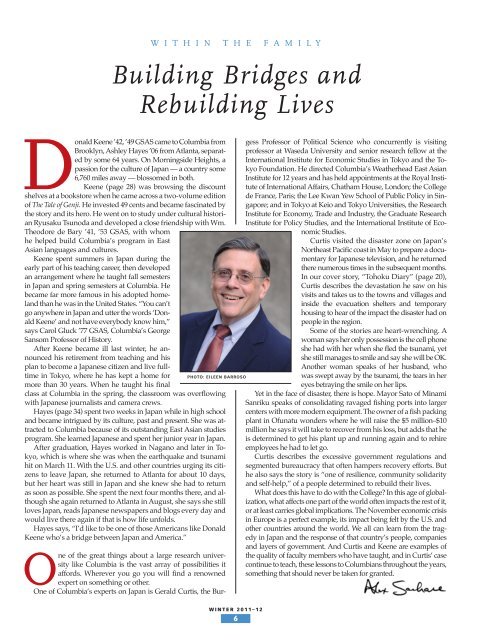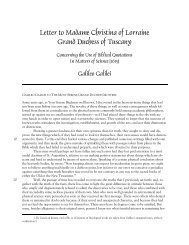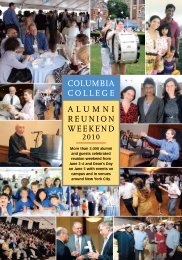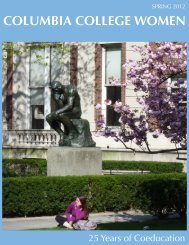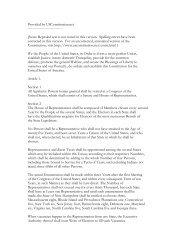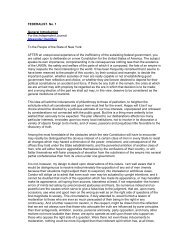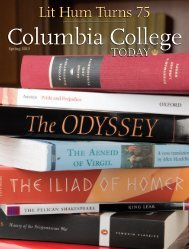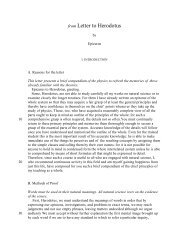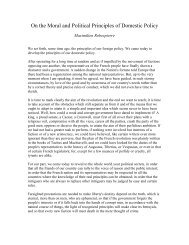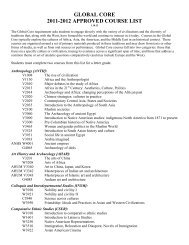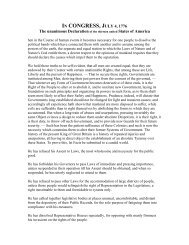Japan Storm - Columbia College - Columbia University
Japan Storm - Columbia College - Columbia University
Japan Storm - Columbia College - Columbia University
Create successful ePaper yourself
Turn your PDF publications into a flip-book with our unique Google optimized e-Paper software.
Donald Keene ’42, ’49 GSAS came to <strong>Columbia</strong> from<br />
Brooklyn, Ashley Hayes ’06 from Atlanta, separated<br />
by some 64 years. On Morningside Heights, a<br />
passion for the culture of <strong>Japan</strong> — a country some<br />
6,760 miles away — blossomed in both.<br />
Keene (page 28) was browsing the discount<br />
shelves at a bookstore when he came across a two-volume edition<br />
of The Tale of Genji. He invested 49 cents and became fascinated by<br />
the story and its hero. He went on to study under cultural historian<br />
Ryusaku Tsunoda and developed a close friendship with Wm.<br />
Theodore de Bary ’41, ’53 GSAS, with whom<br />
he helped build <strong>Columbia</strong>’s program in East<br />
Asian languages and cultures.<br />
Keene spent summers in <strong>Japan</strong> during the<br />
early part of his teaching career, then developed<br />
an arrangement where he taught fall semesters<br />
in <strong>Japan</strong> and spring semesters at <strong>Columbia</strong>. He<br />
became far more famous in his adopted homeland<br />
than he was in the United States. “You can’t<br />
go anywhere in <strong>Japan</strong> and utter the words ‘Donald<br />
Keene’ and not have everybody know him,”<br />
says Carol Gluck ’77 GSAS, <strong>Columbia</strong>’s George<br />
Sansom Professor of History.<br />
After Keene became ill last winter, he announced<br />
his retirement from teaching and his<br />
plan to become a <strong>Japan</strong>ese citizen and live fulltime<br />
in Tokyo, where he has kept a home for<br />
more than 30 years. When he taught his final<br />
class at <strong>Columbia</strong> in the spring, the classroom was overflowing<br />
with <strong>Japan</strong>ese journalists and camera crews.<br />
Hayes (page 34) spent two weeks in <strong>Japan</strong> while in high school<br />
and became intrigued by its culture, past and present. She was attracted<br />
to <strong>Columbia</strong> because of its outstanding East Asian studies<br />
program. She learned <strong>Japan</strong>ese and spent her junior year in <strong>Japan</strong>.<br />
After graduation, Hayes worked in Nagano and later in Tokyo,<br />
which is where she was when the earthquake and tsunami<br />
hit on March 11. With the U.S. and other countries urging its citizens<br />
to leave <strong>Japan</strong>, she returned to Atlanta for about 10 days,<br />
but her heart was still in <strong>Japan</strong> and she knew she had to return<br />
as soon as possible. She spent the next four months there, and although<br />
she again returned to Atlanta in August, she says she still<br />
loves <strong>Japan</strong>, reads <strong>Japan</strong>ese newspapers and blogs every day and<br />
would live there again if that is how life unfolds.<br />
Hayes says, “I’d like to be one of those Americans like Donald<br />
Keene who’s a bridge between <strong>Japan</strong> and America.”<br />
One of the great things about a large research university<br />
like <strong>Columbia</strong> is the vast array of possibilities it<br />
affords. Wherever you go you will find a renowned<br />
expert on something or other.<br />
One of <strong>Columbia</strong>’s experts on <strong>Japan</strong> is Gerald Curtis, the Bur-<br />
W I T H I N T H E F A M I L Y<br />
Building Bridges and<br />
Rebuilding Lives<br />
PHOTO: EILEEN BARROSO<br />
WINTER 2011–12<br />
6<br />
gess Professor of Political Science who concurrently is visiting<br />
professor at Waseda <strong>University</strong> and senior research fellow at the<br />
International Institute for Economic Studies in Tokyo and the Tokyo<br />
Foundation. He directed <strong>Columbia</strong>’s Weatherhead East Asian<br />
Institute for 12 years and has held appointments at the Royal Institute<br />
of International Affairs, Chatham House, London; the <strong>College</strong><br />
de France, Paris; the Lee Kwan Yew School of Public Policy in Singapore;<br />
and in Tokyo at Keio and Tokyo Universities, the Research<br />
Institute for Economy, Trade and Industry, the Graduate Research<br />
Institute for Policy Studies, and the International Institute of Economic<br />
Studies.<br />
Curtis visited the disaster zone on <strong>Japan</strong>’s<br />
Northeast Pacific coast in May to prepare a documentary<br />
for <strong>Japan</strong>ese television, and he returned<br />
there numerous times in the subsequent months.<br />
In our cover story, “Tohoku Diary” (page 20),<br />
Curtis describes the devastation he saw on his<br />
visits and takes us to the towns and villages and<br />
inside the evacuation shelters and temporary<br />
housing to hear of the impact the disaster had on<br />
people in the region.<br />
Some of the stories are heart-wrenching. A<br />
woman says her only possession is the cell phone<br />
she had with her when she fled the tsunami, yet<br />
she still manages to smile and say she will be OK.<br />
Another woman speaks of her husband, who<br />
was swept away by the tsunami, the tears in her<br />
eyes betraying the smile on her lips.<br />
Yet in the face of disaster, there is hope. Mayor Sato of Minami<br />
Sanriku speaks of consolidating ravaged fishing ports into larger<br />
centers with more modern equipment. The owner of a fish packing<br />
plant in Ofunatu wonders where he will raise the $5 million–$10<br />
million he says it will take to recover from his loss, but adds that he<br />
is determined to get his plant up and running again and to rehire<br />
employees he had to let go.<br />
Curtis describes the excessive government regulations and<br />
segmented bureaucracy that often hampers recovery efforts. But<br />
he also says the story is “one of resilience, community solidarity<br />
and self-help,” of a people determined to rebuild their lives.<br />
What does this have to do with the <strong>College</strong>? In this age of globalization,<br />
what affects one part of the world often impacts the rest of it,<br />
or at least carries global implications. The November economic crisis<br />
in Europe is a perfect example, its impact being felt by the U.S. and<br />
other countries around the world. We all can learn from the tragedy<br />
in <strong>Japan</strong> and the response of that country’s people, companies<br />
and layers of government. And Curtis and Keene are examples of<br />
the quality of faculty members who have taught, and in Curtis’ case<br />
continue to teach, these lessons to <strong>Columbia</strong>ns throughout the years,<br />
something that should never be taken for granted.


